As Gulf countries are devising strategies to tackle over the 60% plunge in oil prices year-to-date, Qatar may see budget deficit of $5bn-$10bn in 2015 if crude remains at $50 for the entire year, Amwal has said. However, the country, which has the second lowest breakeven oil price among GCC countries after Kuwait, can easily manage the deficit with its huge sovereign wealth fund (SWF) assets and fiscal reserves to support its massive capital spending on infrastructure, according to Amwal.
Oil has fallen over 40% since the Organisation of Petroleum Exporting Countries maintained its production target at the November 27 meeting.
If Brent crude averages $60 a barrel this year, Gulf Co-operation Council (GCC) states are estimated to run a combined current account deficit of $60bn. Understandably, the plunge in oil prices might be expected to usher in an age of subsidy cuts and fiscal austerity in the Gulf.
Qatar’s budget deficit at $50 oil will be easily manageable with an estimated $115bn worth SWF assets; at $57, it will be breakeven, Afa Boran, Amwal’s head of asset management, said in a recent report.
Driven by the FIFA 2022 and the Qatar National Vision 2030, the country’s “active projects market” has been estimated at $285bn by Meed. Qatar, which posted a fiscal and current account surpluses of 15.6% and 30.9% of GDP respectively in 2013, has the buffers to finance its infrastructure upgrade despite oil’s plunge, QNB said in an earlier report.
According to estimates published in an exclusive column for Gulf Times by Doha Bank Group CEO Dr R Seetharaman, Qatar’s budget of 2014-15 had revenue of $62bn compared with $60bn expenditure: a fiscal surplus of $2bn was based on a conservative estimate of $65 a barrel.
Longer term, however, the Gulf’s fiscal cover will start shrinking if oil stays low. And prices are generally expected to stabilise in the $70-$80 range in the next 12-18 months. In a wider sense, the $100 level, which many Gulf countries said in early 2014 was a fair price for both producers and consumers, is highly unlikely in the foreseeable future, according to experts.
Qatar’s “economic outlook for 2014–2016 is still generally favourable, although falling oil prices could be a key downside external risk if they persist for long”, the Ministry of Development Planning and Statistics said in its Qatar Economic Outlook (QEO) 2014-16 update. However, the impact of falling oil prices on the wider economy is likely to be shielded by the available fiscal headroom, it said, referring to the breakeven prices of $42 and $55 in 2014 and 2015.
In 2016, the breakeven price is expected to be around $71 as government expenditure continues to grow, oil production declines and QP’s financial surplus moderates, the QEO said. “Yet…if required the state’s large financial reserves could be deployed to shore up planned spending,” the report added.
To be sure, it’s not crisis time yet for the well-managed Qatari economy. Longer term, however, falling oil prices could create pressure on economic planning in Qatar, which has an oil-linked pricing mechanism for its LNG supplies. The country’s monetary policy, to an extent, is also constrained by its currency peg to the US dollar. So fiscal discipline is the need of the hour for Qatar as well as other GCC economies, according to Seetharaman.



